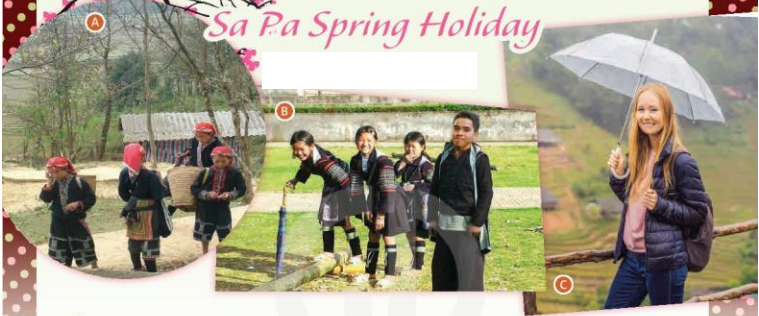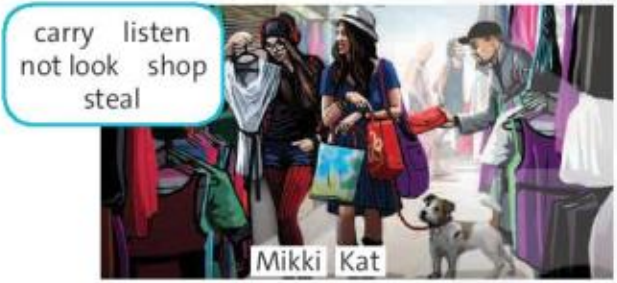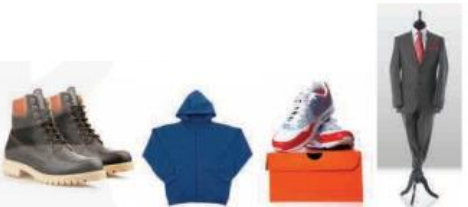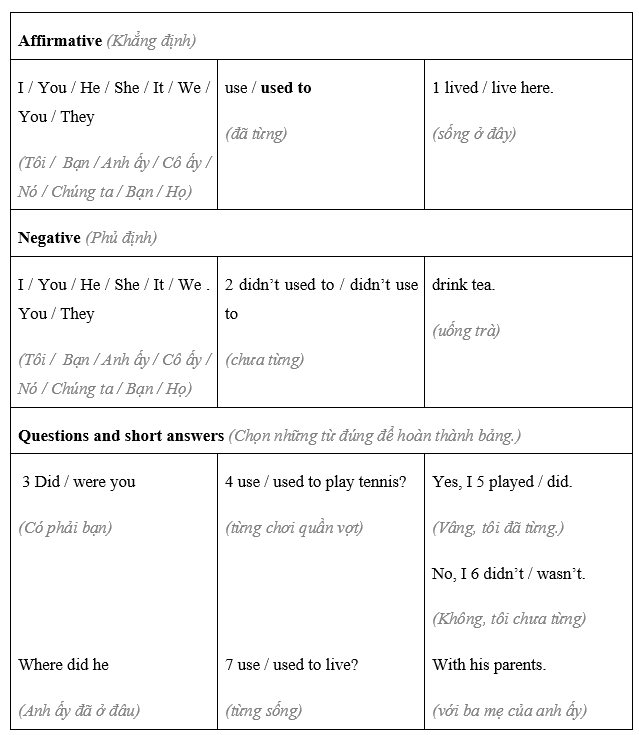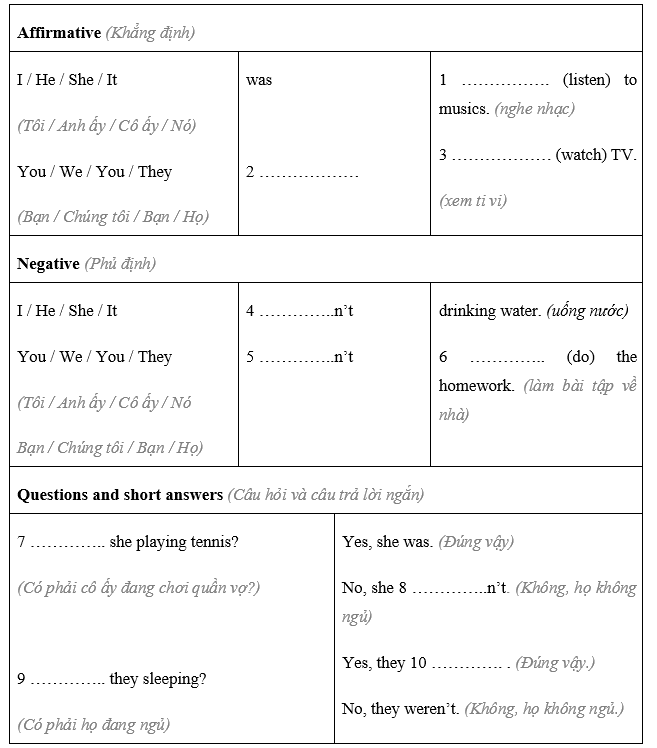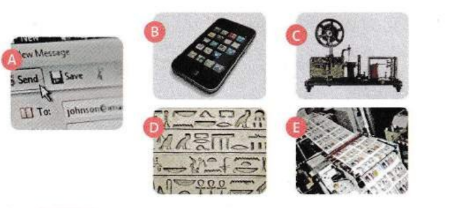Giải SGK, SBT Unit 1. Fads and fashions Friends Plus
Giải SGK, SBT Unit 1. Fads and fashions Friends Plus
1. Work with a partner and do the quiz.
(Làm việc cùng bạn của bạn và giải câu đố.)
|
app |
craze |
fad |
be an infant |
|
gadget |
post (n, v) |
social media |
|
LET’S GO
1. A fad or craze is an activity which become very popular for a short time. Which of these crazes came from Japan?
a. Loom bands
b. Pokémon
c. Beanie Babies
2. When a lot of people ‘like’ and share a photo or video on social media, it gets a lot of… .
a. sees
b. views
c. looks
3. Bluetooth speakers are small gadgets that you can play music on. They became popular around… .
a. 1999
b. 2009
c. 2019
4. Fans on social media look at their favorite celebrity posts. Which footballer was the first to get 100 million Facebook followers?
a. Cristiano Ronaldo
b. Lionel Messi
c. David Beckham
5. Which is the best-selling game app of all time?
a. Tetris
b. Angry Birds
c. Minecraft
6. The Rubik’s Cube is the best-selling toy in history. ‘Speedcubers’ are experts with the cube and the fastest time to solve the puzzle is less than…
a. 5 seconds
b. 5 minutes
c. 5 hours
3. Watch or listen to five people talking about their interests. Match the speakers with topics. Which speaker spends a lot of money on his/ her interest?
(Xem và nghe 5 người nói chuyện về sở thích của họ. Nối tên người nói cùng với các chủ đề. Người nào dành nhiều tiền cho sở thích/ mối quan tâm của mình nhất?)
|
a. Max b. Elizabeth c. Mitchell d. Yana e. Joe |
comics social media sports music games fashion |
- comics: truyện tranh
- social media: kênh truyền thông mạng xã hội
- sports: các môn thể thao
- music: âm nhạc
- games: trò chơi
- fashion: thời trang
1. Study the sentences from the interview on page 12. Then choose the correct answers to complete the rules.
(Nghiên cứu các câu từ bài phỏng vấn trang 12. Sau đó chọn câu trả lời đúng để hoàn thành các quy tắc.)
People used to watch the best pole-sitters.
(Mọi người từng hay xem những người ngồi trên cột giỏi nhất.)
Before, people didn't use to have smartphones.
(Trước đó, mọi người đã từng không sử dụng điện thoại thông minh.)
Did people really use to buy pet rocks?
(Có phải mọi người thực sự đã từng mua những viên đá làm thú cưng?)
|
RULES 1. We use used to + infinitive when we talk about a regular action or state in the past which we do / don't do now. 2. The negative form is didn't use to/didn't used to. 3. The question form is Did...use to/Did used to. |
2. Complete the online article with the words in the box.
(Hoàn thành bài viết trực tuyến với những từ cho trong khung.)
| didn't to use used used |
In the 1920s, dance marathons used to be popular in the USA. People 1_______ to compete for prizes in competitions which lasted for weeks. People 2_______ use to dance perfectly all the time, but they always moved their feet. And they didn't 3_______ to dance twenty-four hours a day. They rested for fifteen minutes every hour. The competitors used 4_______ eat twelve times a day for energy.
3. Look at the pictures of Michael in the past and Michael now. Use the ideas in 1 - 6 to write sentences about his life ten years ago. Use affirmative and negative forms of used to.
(Nhìn vào những bức hình của Michael trong quá khứ và Michael của hiện tại. Sử dụng những ý tưởng từ 1 – 6 để viết các câu về cuộc đời anh ấy mười năm trước. Sử dụng dạng khẳng định và phủ định của used to.)

live in London (sống ở London)
He didn't use to live in London.
(Anh ấy không từng sống ở London.)
|
1. work in an office 2. have longer hair 3. live in the USA |
4. wear smart clothes 5. wear glasses 6. like playing games |
4. USE IT! Write true and false sentences about your past habits. Use affirmative and negative forms of used to and the words in the box.
(Viết những câu đúng và sai về thói quen trong quá khứ của bạn. Sử dụng dạng khẳng định và phủ định của “used to” và các từ trong hộp.)
|
be be interested in cry go have like play watch |
I used to watch cartoons with my sister when was little.
(Tôi từng hay xem hoạt hình cùng với chị/em gái của tôi khi còn nhỏ.)
Work in pairs. Read out your sentences. Guess whether your partner's sentences are true or false.
(Làm việc theo cặp. Đọc to các câu của bạn. Đoán xem câu của bạn của bạn là đúng hay sai.)
A: I used to watch cartoons with my sister when I was little.
(Tớ từng hay xem hoạt hình cùng chị/em gái của tớ khi tớ còn nhỏ.)
B: What cartons did you to watch?
(Cậu đã từng xem phim hoạt hình nào?)
A: The Minions.
(Phim The Minions.)
B: I think that's true!
(Tớ nghĩ điều đó là đúng!)
1. Copy and complete the word-web with the words in the box.
(Sao chép và hoàn thành chuỗi từ vựng với các từ trong hộp.)
|
baggy |
blouse |
colourful |
shorts |
indigo |
|
trainers |
hat |
jacket |
patterned |
shirt |
|
knee-length |
skirt |
scarf |
leggings |
trousers |
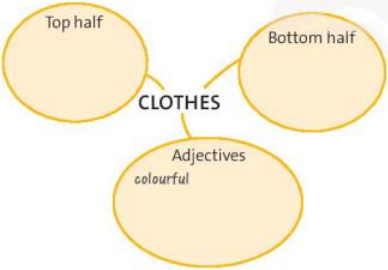
4. Listen to Sam talking to his friend Chloe about his holiday. Which photo is mentioned in the recording?
(Hãy nghe Sam nói chuyện với bạn của anh ấy là Chloe về kỳ nghỉ của anh ấy. Bức ảnh nào được nhắc đến trong đoạn ghi âm?)
|
STUDY STRATEGY (Chiến lược làm bài) Listening for specific information (Lắng nghe những thông tin cụ thể) 1. Read the questions carefully. (Đọc các câu hỏi một cách cẩn thận.) 2. Underline the important words. (Gạch chân dưới những từ quan trọng.) |
Past continuous (Quá khứ tiếp diễn)
1. Complete the sentences from the listening on page 14 with the words in the box. Then choose the correct option in the rule.
(Hoàn thành những câu từ bài nghe trang 14 với các từ trong hộp. Sau đó chọn lựa chọn chính xác trong phần quy tắc.)
|
was |
wearing |
were |
doing |
1. What were you.......................in Sa Pa?
2. We.......................visiting my dad for a couple of weeks.
3. I.......................walking down the street with my sister.
4. The girls were.......................long indigo blouses over knee-length shorts.
|
RULE We use the past continuous to describe short actions / long actions in the past. |
3. Complete the questions using the past continuous form of the verbs in the box. Then ask and answer the questions with a partner.
(Hoàn thành các câu hỏi sử dụng dạng quá khứ tiếp diễn của các động từ trong hộp. Sau đó hỏi và trả lời các câu hỏi với một người bạn.)
| do | shine | sit | talk |
1. What …… your mother …… at six o'clock yesterday evening?
2. Who…..you ..... to this time last week?
3. ….. the sun ….. last Sunday?
4. Where ...... you ….. this time yesterday?
Past simple and past continuous (Quá khứ đơn và quá khứ tiếp diễn)
4. Study sentences 1- 4. Then match them with rules a-d. Which tenses do we use in each sentence? How do you say when and while in Vietnamese?
(Nghiên cứu các câu từ 1- 4. Sau đó ghép chúng với quy tắc a-d. Những thì nào chúng ta sử dụng trong mỗi câu. Bạn nói “when” và “while” bằng tiếng Việt như thế nào?)
1. We were waiting for a bus when I took this photo.
(Chúng tôi đang chờ xe buýt khi tôi chụp bức ảnh này.)
2. The girl was wearing a colourful dress.
(Cô gái đang mặc một chiếc váy đầy màu sắc.)
3. They saw my Manchester United shirt.
(Họ đã nhìn thấy chiếc áo Manchester United của tôi.)
4. While I was talking to him, my sister was learning Japanese words.
(Trong khi tôi nói chuyện với anh ấy, chị gái của tôi đang học từ vựng tiếng Nhật.)
|
RULES We use these past tenses to talk about: (Chúng ta sử dụng những thì quá khứ này khi nói về) a. a long action in the past. (một hành động kéo dài trong quá khứ.) b. a shorter action in the past. (một hành động ngắn hơn trong quá khứ.) c. two simultaneous, longer actions. (hai hành động đồng thời, kéo dài hơn.) d. a longer, continuous action interrupted by a shorter action. (một hành động tiếp diễn kéo dài bị xen ngang bởi một hành động ngắn hơn.) |
1. Complete the dialogue with the phrases in the box. Then watch or listen and check. What does Hugo think of Sammy's trousers? Why is Hugo buying a shirt?
(Hoàn thành cuộc đối thoại với các cụm từ trong hộp. Sau đó xem hoặc nghe và kiểm tra. Hugo nghĩ gì về quần của Sammy? Tại sao Hugo lại mua một chiếc áo sơ mi?)
|
decide expensive few weeks interesting shirt look smart wedding |
Hugo: Hi, Sammy.
Sammy: Oh, hi, Hugo.
Hugo: Those are cool trousers.
Sammy: Really? I think they're a bit baggy.
Hugo: They're supposed to be like that. I bought a pair like that a 1_______ ago and they're so comfortable. They look really good.
Sammy: Maybe I'll buy them, then. That's an 2_______ you're wearing.
Hugo: It's not really my style, but I'm going to a 3_______ next week and Mum wants me to wear something 4_______. What do you think of this one?
Sammy: That's better. It's 5_______ though.
Hugo: You're right, it is.
Sammy: But your mum does want you to 6_______ smart.
Hugo: Mmm, true. Why don't I try it on and then 7_______?
2. Cover the dialogue and circle the words in italics in the Key Phrases that Hugo and Sammy use. Watch or listen again and check.
(Che đoạn hội thoại và khoanh tròn các từ in nghiêng trong Cụm từ chính mà Hugo và Sammy sử dụng. Xem hoặc nghe lại và kiểm tra.)
|
KEY PHRASES Shopping for clothes They look really 1good / well. They're a bit 2baggy / tight. What do you think 3about / of this one? It's (not) really my 4interest / style. It's 5expensive / comfortable, though. Why don't you try it 6on / out. |
4. PRONUNCIATION: /u:/ and /ʊ/. Listen and repeat. Which sound, /u:/ or /ʊ/, has each word got?
(PHÁT ÂM: /u:/ và /ʊ/. Lắng nghe và lặp lại. Mỗi từ có âm nào, /u:/ hoặc /ʊ/?)
| 1. blue | 3. cool | 5. good |
| 2. look | 4. shoes | 6. suit |
6. USE IT! Work in pairs. Read the situation. Then prepare and practise a new dialogue using the key phrases and the dialogue in exercise 1 to help you.
(Làm việc theo cặp. Đọc tình huống. Sau đó chuẩn bị và thực hành một đoạn hội thoại mới bằng cách sử dụng các cụm từ chính và đoạn hội thoại trong bài tập 1 để giúp bạn.)
|
Student A: You see a friend in a shop. He/ She asks for your opinion. You're not sure, so you show your friend something different. (Học sinh A: Bạn nhìn thấy một người bạn trong một cửa hàng. Anh ấy / Cô ấy hỏi ý kiến của bạn. Bạn không chắc chắn, vì vậy bạn chỉ cho bạn mình thấy một cái gì đó khác.) |
|
Student B: You meet a friend in a shop. You want his/her opinion on something you're thinking of buying. Listen to your friend's suggestion. You think it's too expensive, so suggest going to another shop. (Học sinh B: Bạn gặp một người bạn trong một cửa hàng. Bạn muốn biết ý kiến của anh ấy/cô ấy về thứ mà bạn đang tính mua. Hãy lắng nghe lời đề nghị của người bạn. Bạn cho rằng đắt quá nên đề nghị đi cửa hàng khác.) |
1. Read the fact file. What things were popular in the eighties? Work in pairs. Tell your partner what was popular in the eighties using the phrases.
(Đọc tài liệu thực tế. Những điều gì đã phổ biến trong thập niên tám mươi? Làm việc theo cặp. Nói với bạn của bạn những gì phổ biến trong thập niên tám mươi cách sử dụng các cụm từ.)
Fads and fashions of the eighties in Việt Nam
FASHION
During this decade, the most common outfit for Vietnamese people was a loose shirt and flared trousers. Especially, rich girls used to wear shirts with lotus collars or vintage dresses.
MUSIC
The eighties was the decade when Vietnamese pop music developed. The songs of musicians like Nguyễn Ngọc Thiện and Nguyễn Văn Tỷ praised a new life. For example, Ơi Cuộc Sống Mến Thương and Bài Ca Năm Tấn were about the nation building.
TECHNOLOGY
At that time technology was more basic. Television started to become popular in the 1980s, but people only had black-and-white TVs, for instance.
CRAZES
There were crazes for fun things, such as tug of war, bamboo jacks and blind man's buff. In those days, they were a massive trend for teenagers.
|
KEY PHRASES (Cụm từ khóa) Describing a specific time period in the past (Diễn tả một khoảng thời gian cụ thể trong quá khứ) In the (eighties), ... (Trong (thập niên tám mươi), …) It was the decade when ... (Đó là thập kỷ khi mà….) In those days, ... (Trong những ngày ấy, …) At that time, ... (Vào thời đó, …..) During this decade / era, ... (Trong suốt thập kỷ / thời đại này, ….) |
CÁC BÀI TẬP KHÁC


